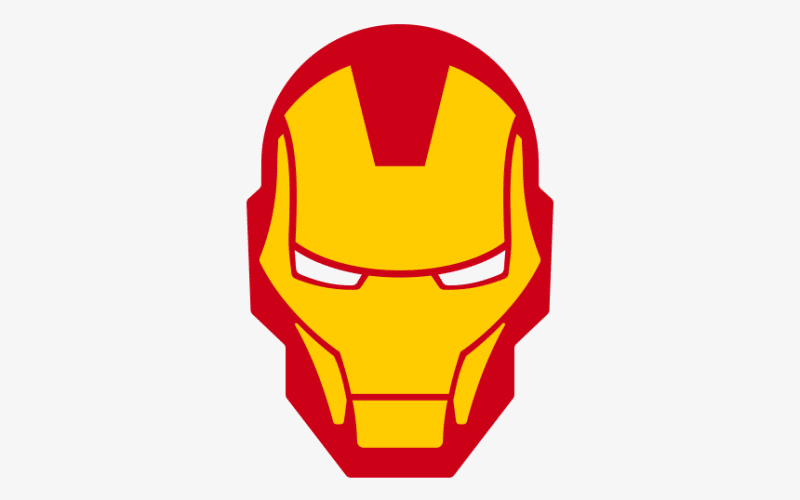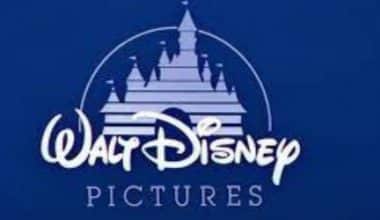The Iron Man logo is a simple yet distinctive superhero emblem. Even though the Marvel Cinematic Universe and Marvel Comics use different versions of this logo, they both have something about Iron Man that is unique. The emblem for Marvel Comics is a thick outline of Iron Man’s helmet, while the logo for the Marvel Cinematic Universe is an outline of the arc reactor on Iron Man’s suit.
But first, let’s go through everything from the beginning.
The History and Evolution of the Iron Man Logo
Anthony Edward “Tony” Stark, a prodigy, physicist, playboy, and business magnate, is the character’s fictional precursor. He is the one who hides behind the Iron Man mask, which he constructed to safeguard justice. When his kidnappers force him to construct mass destruction weapons, he creates one-of-a-kind automated armor for himself. The inventor hoped to escape from captivity and foes with their assistance. In future versions of the comics and films, Anthony Edward disguises himself as Iron Man and uses armor to safeguard the planet.
The superhero owes his appearance to the Avengers, of which he was a member. The solo version of the logo was released in May 1968, concurrently with the publication of the adventures. There are a total of five seasons about him, which came out in parts from 2008 to 2012. Then there was The Invincible Iron Man, which ran until 2014.
Following that, a recognizably identifiable image encapsulated in a personal insignia was employed in films, games, cartoons, and TV shows. On the cover of the first magazine, the prototype logo already had spikes, seams, and other metal parts that would later become personal symbols.
Read Also: 20th Century Fox Logo: Facts and History
The true Iron Man logo was hand-drawn by a superhero. It began with simplified graphics in the form of a geometric shape mask (in Avengers). The head in the helmet is depicted after the first film’s release. Straight lines, clean corners, and sharp protrusions distinguish it from genuine metal objects.
However, before arriving at the final version, Marvel Studios personnel had to go through a large number of versions. The metallic textures and gradients are the major focus. Because of this, the logo now has both a graphic sign and a stylized word. It is several years old because it was released at the same time as the next picture – in 2008, 2010, and 2013.
Unlike many other well-known superheroes, Iron Man’s visual identity is in the form of an inscription. The inscription occasionally included a pictorial element, but the majority of variations used bright, bold letters that appeared powerful and confident.
1968 — 1969
The initial Iron Man sign was presented in 1968, and it included a red bold uppercase inscription with a slim black outline and characteristic shadow, which emphasized the inscription’s tight and straight lines. Above the inscription, the word mark “The Invisible” was added in an elongated sans-serif with only red accents and no black accents.
1969 — 1984
The 1964 logo update altered the superhero’s insignia, which remained with Iron Man for 15 years. It was made up of three-dimensional red and blue letters, with the front parts in red and black and all sides of the squares in blue. The extra word mark “The Invincible” was written in light blue and displayed in the same font as the previous design.
1984 — 1985
The Iron Man logo’s color scheme was changed to white, red, and yellow, and Iron Man’s image was moved to the left side of the inscription. The word “Marvel” was added above the Iron Man image in a bespoke black typeface, while the word mark “The Invincible” was removed.
1985 — 1987
In 1985, the Iron Man logo was recreated in a more modern, progressive style, with the color scheme of its huge letters changed to orange and white and the text placed in two rows against a black background.
1988 — 1996
The 1988 Iron Man logo makeover changed the symbol’s color palette to blue and yellow, with its big letters in a chunky white outline set against a black backdrop. The white dots and contour of each letter reflected the “Iron” in Iron Man, giving the emblem a strong and distinct appearance.
1996 — 1997
The inscription was redesigned in 1986 in a new black and silver color scheme, with the upward surface of bold lettering metallic and many rounded screws put vertically in each letter.
1997 — 2002
The wordmark “The Invincible” was restored to Iron Man’s visual identity in 1997. The Iron Man inscription was created in rounded yellow letters, with the additional writing “The Invincible” in smooth blue put above it. The two components of the visual identity were set against a green, soothing gradient background.
2002—2008
In 2002, the Iron Man insignia was changed once more, with the usual strong writing in an ascending red outline against a white background. The bodies of the letters were all done in pale yellow and accented with dots and tiny red lines.
2009 — 2013
The Iron Man inscription was inscribed in large black letters and had a sleek, shiny silver outline with gradient tints, similar to a true metallic insignia. The inscription had a silky gray shadow, which added volume and made the sign appear three-dimensional and airy.
2013 — 2014
After four years of having a monochromatic design, Iron Man’s logo was replaced with a colorful version in 2013. It was sleek red lettering set against a blue background, with small outline letters and an uneven pattern. This new inscription was created in a geometric and robust sans-serif typeface, with each letter appearing substantial and powerful.
2014 to the Present
The Iron Man logo was last updated in 2014. The letters were written in a bespoke typeface, glued together, and even slightly overlapped each other. Each letter is designed in dark red with a black and pale yellow outline and geometrically cut edges.
The core of the “M” was lengthened and sharpened, giving the logo a sense of resolve and menace, while the “O” was replaced by an iconic octagon containing a light yellow circle (symbolizing Iron Man).
Symbol
Since 2008, a number of Iron Man sequels have been released, and the original logotype has undergone new variations. They did, however, keep the general letter shapes quite similar.
Iron Man’s Rejected Emblem
Before Marvel Studios arrived at the final version of the logo, it had to go through several versions, some of which came from well-known authors. For example, graphic artist Fede Ponce designed a set of wordmarks for the film “Iron Man and Thor: The Dark World.” Ponce stated that some of the notions he was supposed to depict in his work included “redemption” and “being broken and then reborn.”
All of these things were represented in the design by metal textures and gradients, which Ponce used and which were also used in the final wordmark, but in a different way.
Iron Man Logo Font & Colors
Any of the logo elements has a simple, minimalist design with few broken or bent lines. Everything is exceedingly hard and pointy in order to accentuate the character’s rigidity. Even the inscriptions have a metallic sheen, in keeping with the concept of Iron Man.
The term utilized in the first action film (2008) was created by Paramount Studios’ Josh Greenstein. Nancy Goliger, a colleague in the film workshop, gave him this job. Inscriptions are distinguished by upper case symbols, iron textures, and reflections from metal surfaces.
To accentuate iron, the painters used rusty tones of red, brown, and orange, blending them with classic black and white.
Can I use Marvel logo?
To use the copyrights for the real photos and drawings of the characters, you have to buy a license. You need a license to use the trademarks associated with the Marvel and DC logos, as well as the logos for some characters.
The Origins of Iron Man
Iron Man is a fictional American superhero who originally appears in a Marvel Comics comic book in 1963. Stan Lee, screenwriter Larry Lieber, and artists Jack Kirby and Don Heck came up with the idea. Iron Man first appeared in the March 1963 issue of Tales of Suspense.
Iron Man has appeared in his own comic books, as a regular guest in other well-known comics (including the Avengers comic series), in animated films and TV series, and in live-action films.
The History of Iron Man
Tony Stark, as a child, was a mechanical engineering genius. The 21-year-old genius took over his father’s company and turned it into a tremendous success. While testing new technology in Vietnam, Stark was hit by shrapnel from a hidden explosive device. A piece of shrapnel became lodged near his heart, threatening his life.
While he was in Vietnam, a communist leader kidnapped and locked him up. The leader forced him to make new weapons for the dictator. Professor Ho Yinsen, a renowned physicist, was imprisoned alongside Stark. They collaborated to develop the first armor suit, which became Iron Man. Professor Yinsen even devised a device to keep Stark’s heart beating.
Stark used the armor to flee, but Professor Yinsen died in the process, giving Stark time to fully recharge the armor. Stark escaped with James Rhodes, who is now a member of War Machine, and went back to the United States to join the Avengers. He used his brand-new armor to help people, just as his father had taught him to do. However, he had flaws as well, having struggled with alcohol addiction his entire life.
While a member of the Avengers and a hero in his own right, Stark continued to grow his firm to multibillion-dollar proportions. He developed and sold technology to S.H.I.E.L.D. and other organizations, such as the Avengers Quinjet. Obadiah Stane, a rival billionaire who ran a company that made weapons, was jealous of the success of Stark’s company.
Read Also: APPLE MUSIC LOGO: History, Evolution & All You Should Know
Obadiah vowed to destroy Stark and eventually take over his company. This set off a cascade of events that resulted in Stark becoming homeless. As a result, he was compelled to return to the bottle and hand over the Iron Man title to his friend Jim Rhodes. To make matters worse, Stane found Iron Man’s armor designs and began working on his own version, dubbed the Iron Monger, which he intended to sell to the highest bidder.
Stark finally got his life back on track, founded a new business, and reclaimed his identity as Iron Man. His new business was called Circuits Maximum, which made Stane angry and led to a fight between Iron Man and Iron Monger. Stane lost the fight, freeing Stark to reclaim his life and company.
Later, when more and more bad guys started to wear armor like Iron Man’s, Stark started to use a new technology called “Armor Wars.” He stopped the government and supervillains from using the copied designs, taking back what was legally his.
Stark helped form the Illuminati, a group of other people with superpowers who worked to take control of the world, because the world was facing big problems. Iron Man, Professor X, Sub Mariner, Black Bolt, Dr. Strange, and Reed Richards comprise the team.
Read Also: PUNISHER LOGO: The True Meaning of the Controversial Logo, Revealed!!!
People say that they found the Infinity Gems, which, when used with the Infinity Gauntlet, give the user godlike powers. Also, the Illuminati were the ones who launched Hulk into space, kicking off World War Hulk.
Tony Stark also played a significant role in Civil War, in which the government encouraged heroes to sign up for the War, give up their identities, and essentially become S.H.I.E.L.D. Agents. This did not sit well with many heroes, who did not want to relinquish their identities or undertake the dirty job of the government, so they went underground.
The heroes eventually split into two groups. There were those who supported the registration, led by Iron Man, who became the Director of S.H.I.E.L.D., and those who opposed it, led by Captain America.
The Civil War shattered the Marvel Cinematic Universe, ending in an epic fight in New York. However, when Captain America understood the cost of the war on America, he called for a cease-fire and surrendered to the authorities. Later, he was slain on his way to court for his trial, for which Stark feels responsible.
Tony Stark has recently expressed concern about Skrulls infiltrating super-powered organizations and institutions. The biggest problem is that Skrulls are invisible to humans, therefore, everyone is a suspect. Stark takes on the Skrulls, bringing out the best in humanity and trying to find a means to stop this hidden invasion.
Strength, Weapons, Paraphernalia, and Enemies of Iron Man
Without his armor, Stark possesses the typical strength of a person of his build, height, and age who engages in acceptable regular workouts. With his armor on, Stark’s strength is amplified to otherworldly proportions, allowing him to push (lift) approximately 85 times.
Iron Man wears a stylish piece of body armor that hides a lot of weapons. Their exact specs are contained within the armor.
In terms of his other skills, Iron Man is a genius who has made many important inventions, discoveries, and other technological advances.
Iron Man has faced a slew of adversaries over the years. His main enemies include his archenemy Mandarin and the Russian spies Crimson Dynamo, Iron Monger, and Justin Hammer. Whirlwind, Firepower, Doctor Doom, Backlash, Titanium Man, and Ghost are among the other foes.
In Conclusion,
Iron Man is a superhero who appears in Marvel Comics’ American comic books. Stan Lee co-created the superhero, which was expanded by scriptwriter Larry Lieber and designed by illustrators Jack Kirby and Don Heck. Iron Man made his big debut in Tales of Suspense in March 1963, and he earned the title Iron Man in 1968. Iron Man was also a member of the Avengers squad in 1963, alongside Thor, Hulk, Wasp, and Ant-Man.
Stan Lee initially utilized Iron Man to experiment with Cold War themes, particularly the importance of American technology in defeating communism. Subsequent Iron Man remakes have moved away from Cold War themes and toward contemporary challenges.
Several animated television series and films have been inspired by Iron Man. In the Marvel Cinematic Universe, Robert Downey Jr. portrays Iron Man in films such as Iron Man, The Incredible Hulk, Iron Man 2, The Avengers, Iron Man 3, Avengers: Age of Ultron, Captain America: Civil War, Spider-Man: Homecoming, Avengers: Infinity War, and Avengers: Endgame.
Related Articles
- PUNISHER LOGO: The True Meaning of the Controversial Logo, Revealed!!!
- BUSINESS PLAN OUTLINE: Developing a Business Plan Outline In 6 Easy Steps [Free Download]
- Why lazy people succeed more as entrepreneurs
- ADVERTISING CAMPAIGN: Definition and Best 20 Campaign Examples and Ideas.
- Dry Cleaning Business: How to Successfully Run One (+ quick guide)






